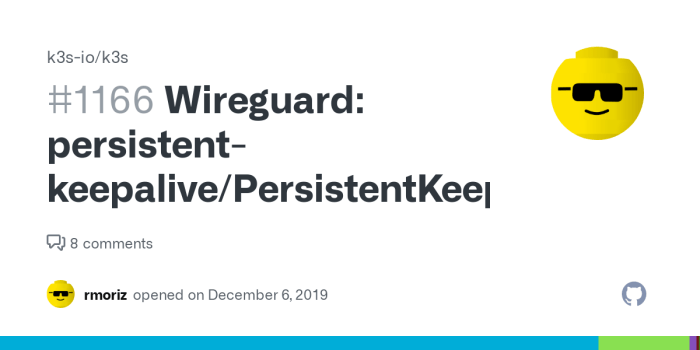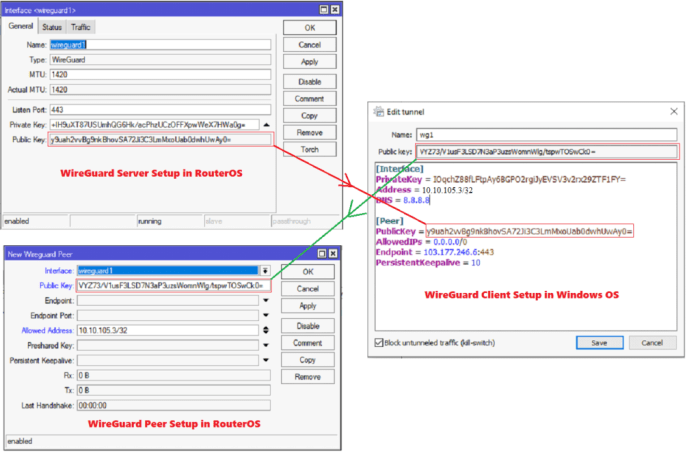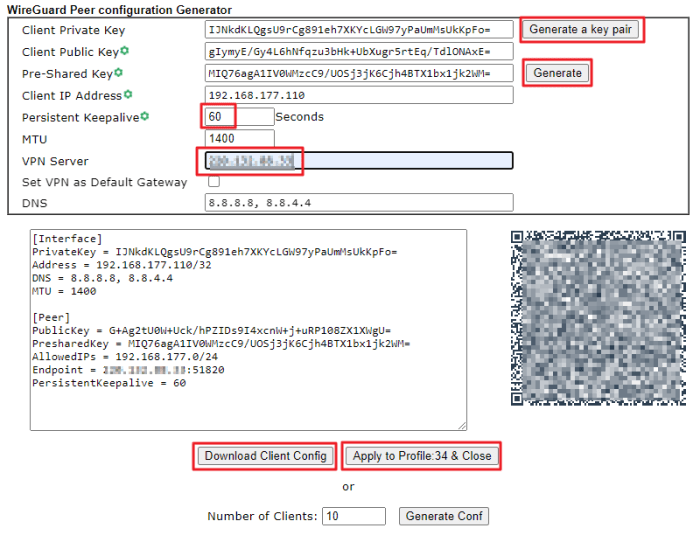In the realm of virtual private networks (VPNs), WireGuard stands out as a modern and highly efficient protocol. Among its many features, persistent keepalive plays a crucial role in maintaining reliable and performant connections. This article delves into the concept of persistent keepalive in WireGuard, exploring its benefits, configuration, troubleshooting, and best practices.
We will also examine its performance impact and compare it with other keepalive mechanisms.
Persistent keepalive is a technique that ensures a continuous exchange of small packets between VPN endpoints. By maintaining an active connection, it prevents the VPN tunnel from timing out due to inactivity, resulting in seamless connectivity even during periods of low traffic.
This feature is particularly valuable for mobile devices or users with intermittent internet access, ensuring uninterrupted VPN protection.
Persistent Keepalive Overview
Persistent keepalive is a feature in WireGuard that allows the VPN tunnel to remain active even when there is no active traffic flowing through it. This is achieved by sending regular keepalive packets between the peers, ensuring that the tunnel remains open and responsive.
Persistent keepalive provides several benefits, including improved reliability, reduced latency, and faster reconnection times. It is particularly useful in scenarios where the VPN connection may experience intermittent connectivity, such as when using a mobile device or when connecting over a congested network.
Benefits of Persistent Keepalive
- Improved reliability: By keeping the VPN tunnel active, persistent keepalive ensures that the connection remains stable even during periods of inactivity.
- Reduced latency: With persistent keepalive, the VPN tunnel is always ready to transmit data, eliminating the need to re-establish the connection when traffic resumes.
- Faster reconnection times: If the VPN connection is interrupted, persistent keepalive allows the peers to quickly re-establish the tunnel without having to go through the full handshake process.
Configuring Persistent Keepalive

Persistent keepalive ensures that WireGuard connections remain active even during periods of inactivity. This is useful for maintaining a stable connection and preventing interruptions caused by network fluctuations or power outages.
Configuring Persistent Keepalive on Linux
To configure persistent keepalive on Linux, add the following line to the [Interface] section of your WireGuard configuration file:
PersistentKeepalive = 25
Replace 25 with the desired keepalive interval in seconds.
Configuring Persistent Keepalive on Windows
On Windows, persistent keepalive is configured using the PersistentKeepaliveInterval setting in the [Peer] section of the WireGuard configuration file:
[Peer] PublicKey = ... PersistentKeepaliveInterval = 25
As with Linux, replace 25 with the desired keepalive interval in seconds.
Configuring Persistent Keepalive on macOS
For macOS, persistent keepalive can be configured using the KeepAlive setting in the [Interface] section of the WireGuard configuration file:
[Interface] PrivateKey = ... KeepAlive = 25
Once again, replace 25 with the desired keepalive interval in seconds.
Troubleshooting Persistent Keepalive

Persistent keepalive can enhance the stability and reliability of WireGuard connections, but it may occasionally encounter issues. This section identifies common problems and provides troubleshooting tips to resolve them.
Configuration Errors
Ensure that the persistent keepalive settings are configured correctly. Check for any typos or syntax errors in the configuration files.
Firewall Rules
Verify that the firewall rules allow traffic on the UDP port specified for persistent keepalive. If the port is blocked, the keepalive packets will not be able to reach their destination.
Network Connectivity Issues
Persistent keepalive relies on a stable network connection. Check for any network outages or connectivity problems that may be preventing the keepalive packets from being sent or received.
Resource Exhaustion
If the system is experiencing resource exhaustion, such as high CPU or memory usage, it may impact the performance of persistent keepalive. Ensure that the system has sufficient resources to handle the additional load.
Logs and Debugging
Examine the WireGuard logs for any error messages or indications of keepalive failures. These logs can provide valuable insights into the root cause of the problem.
Performance Impact of Keepalive
Persistent keepalive in WireGuard has minimal performance implications compared to other keepalive mechanisms. It does not introduce significant overhead or latency and maintains a reliable connection even during periods of inactivity.
In comparison to on-demand keepalive, which only sends keepalive packets when there is no traffic, persistent keepalive continuously sends keepalive packets at regular intervals. This ensures a more consistent and reliable connection, especially for long-lived connections or connections with intermittent traffic.
The frequency of keepalive packets can be customized to balance performance and reliability. A higher frequency may improve reliability but may also increase network traffic. A lower frequency may reduce traffic but may increase the likelihood of connection drops during periods of inactivity.
Advanced Configurations for Persistent Keepalive
Persistent keepalive in WireGuard offers advanced configuration options that enable customization to meet specific requirements. These options provide flexibility and control over the keepalive behavior, allowing users to optimize performance and reliability in various scenarios.
Configuring Keepalive Intervals
One of the advanced configuration options is the ability to configure the keepalive intervals. By default, WireGuard uses a keepalive interval of 25 seconds. However, this value can be adjusted to suit specific network conditions or performance requirements.For example, in environments with high latency or unreliable connections, a shorter keepalive interval may be beneficial to maintain a persistent connection.
On the other hand, in low-latency environments, a longer keepalive interval may be appropriate to reduce unnecessary overhead.To configure the keepalive interval, the following setting can be added to the WireGuard configuration file:“`PersistentKeepaliveInterval = 30“`This setting specifies a keepalive interval of 30 seconds.
Comparison with Other Keepalive Mechanisms
Persistent keepalive offers several advantages over other keepalive mechanisms used in VPNs:
- Reliability: Unlike traditional keepalives, persistent keepalive does not rely on periodic probing, which can be unreliable in scenarios with intermittent connectivity. It establishes a persistent connection between peers, ensuring constant availability.
- Lower overhead: Compared to periodic keepalives, persistent keepalive generates less overhead on the network. This is because it only sends keepalive packets when there is no active traffic, reducing bandwidth consumption and minimizing latency.
- Increased security: By maintaining a persistent connection, persistent keepalive can help detect and mitigate security threats more effectively. It can identify unauthorized access attempts and proactively terminate compromised connections.
However, persistent keepalive also has some disadvantages:
- Increased resource consumption: Maintaining a persistent connection requires more system resources, such as memory and CPU, compared to traditional keepalives.
- Potential for connection issues: If the persistent connection is disrupted due to network issues or other factors, it may take longer to re-establish the connection compared to traditional keepalives.
Best Practices for Using Persistent Keepalive

Persistent keepalive is a valuable tool for maintaining reliable connections in WireGuard deployments. Here are some best practices to ensure its effective utilization:
Environment Considerations
When deploying persistent keepalive, consider the following factors:
- Network latency: High latency can impact keepalive effectiveness. Adjust keepalive intervals accordingly.
- Packet loss: Persistent keepalive can help mitigate packet loss, but excessive packet loss may require additional troubleshooting.
- Network congestion: Congestion can affect keepalive packets, so monitor network conditions and adjust keepalive settings as needed.
Potential Pitfalls
Be aware of potential pitfalls when using persistent keepalive:
- Excessive keepalive traffic: Overly frequent keepalive packets can consume bandwidth and impact network performance.
- Battery drain: Persistent keepalive can contribute to battery drain on mobile devices. Optimize keepalive intervals for mobile use.
- Security implications: Keepalive packets can be intercepted and analyzed, potentially revealing network topology or activity patterns.
Recommendations
For optimal results, consider the following recommendations:
- Start with conservative keepalive intervals (e.g., 25 seconds) and adjust based on network conditions.
- Monitor keepalive statistics to identify any issues or inefficiencies.
- Use encryption to protect keepalive packets from eavesdropping.
- For mobile devices, disable persistent keepalive when battery life is a concern.
Security Implications of Persistent Keepalive
Persistent keepalive offers numerous advantages but also introduces potential security implications that require careful consideration.One concern is the increased risk of denial-of-service (DoS) attacks. Persistent keepalive maintains open connections between peers, providing a potential avenue for attackers to flood the target with keepalive packets, consuming resources and disrupting normal operations.
To mitigate this risk, it’s crucial to implement rate-limiting mechanisms to prevent excessive keepalive traffic.Another security concern is the potential for man-in-the-middle (MITM) attacks. With persistent keepalive, attackers could intercept and modify keepalive packets, potentially gaining access to sensitive data or disrupting the communication channel.
To address this issue, strong encryption and authentication mechanisms, such as mutual TLS (mTLS), should be employed to protect the integrity and confidentiality of the keepalive connection.
Vulnerabilities and Mitigation Strategies
- DoS Attacks: Implement rate-limiting mechanisms to prevent excessive keepalive traffic.
- MITM Attacks: Use strong encryption and authentication mechanisms, such as mTLS, to protect the keepalive connection.
Real-World Examples of Persistent Keepalive
Persistent keepalive has gained traction in various practical applications due to its ability to maintain reliable connections over extended periods.
One notable example is in cloud computing environments, where virtual machines (VMs) often need to communicate with each other securely and efficiently. Persistent keepalive ensures that these connections remain active, even when there is no active traffic, preventing disruptions and data loss.
Benefits and Challenges
The benefits of using persistent keepalive in real-world applications include:
- Improved reliability and reduced latency by maintaining active connections.
- Increased efficiency by avoiding the overhead of re-establishing connections.
- Enhanced security by preventing unauthorized access to inactive connections.
However, there are also some challenges to consider:
- Increased resource consumption, as keepalive packets are sent regularly.
- Potential for performance degradation if the keepalive interval is set too frequently.
- Security implications if the keepalive mechanism is not properly configured.
Future for Persistent Keepalive
The future of persistent keepalive in WireGuard is promising, with several potential developments and advancements on the horizon.
Emerging Trends and Research
One emerging trend is the integration of persistent keepalive with other WireGuard features, such as roaming and mesh networking. This integration will enhance the overall stability and reliability of WireGuard connections, especially in mobile and dynamic environments.
Research is also ongoing to improve the performance and efficiency of persistent keepalive. New algorithms and optimizations are being explored to minimize the overhead and latency associated with keepalive packets.
Last Word
In conclusion, persistent keepalive is an essential feature in WireGuard that enhances VPN reliability, performance, and user experience. Its benefits far outweigh any potential drawbacks, making it a valuable tool for maintaining secure and stable VPN connections. As WireGuard continues to evolve, we can expect further advancements in persistent keepalive and other features that will push the boundaries of VPN technology.